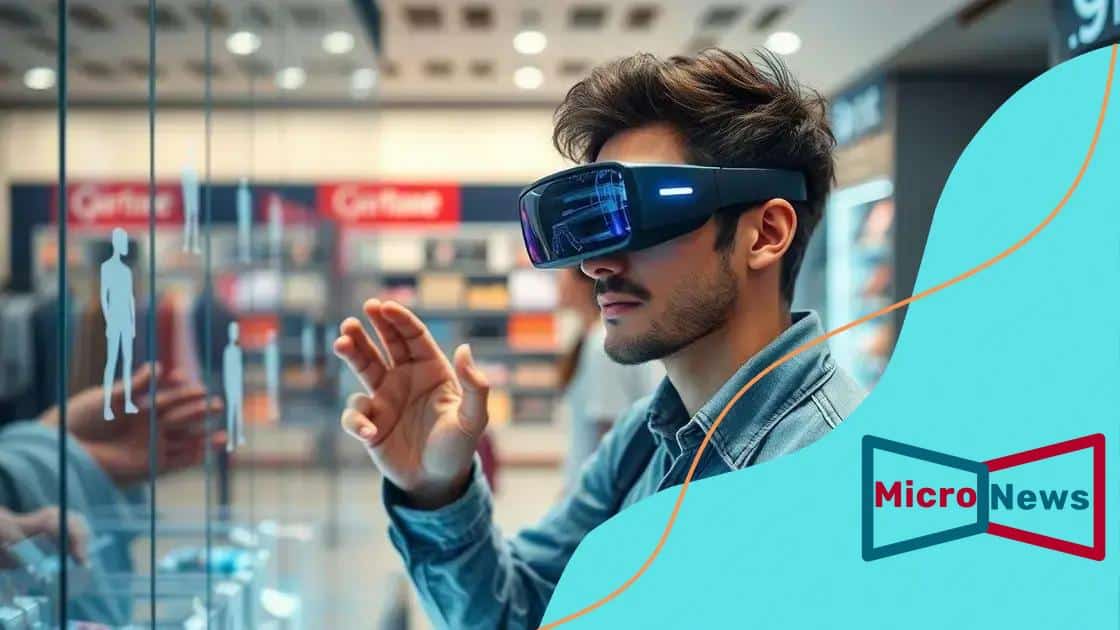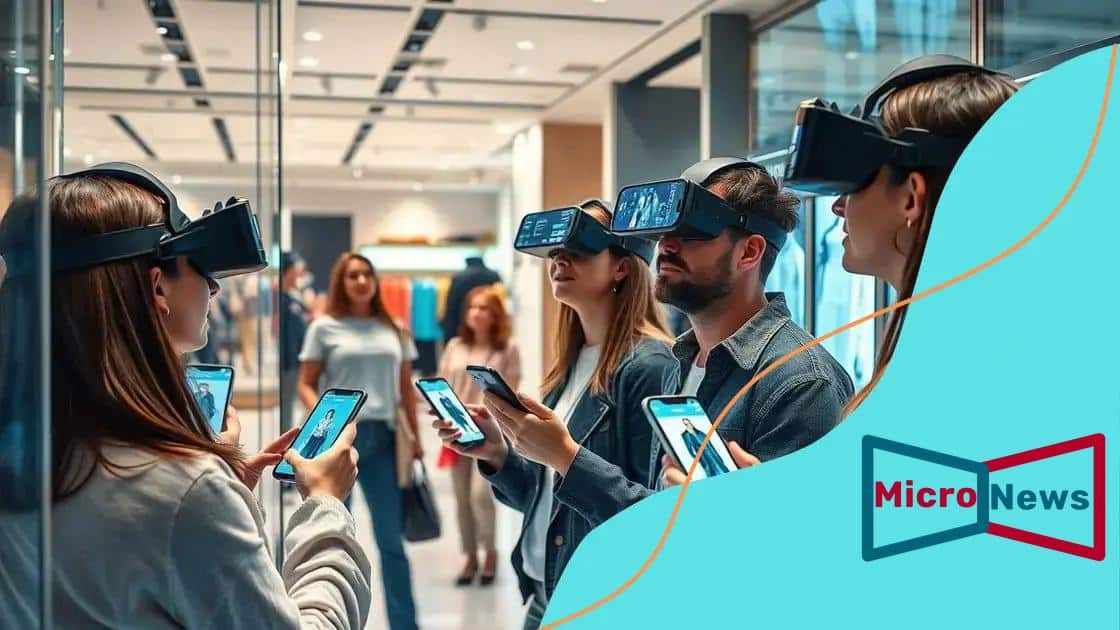Augmented reality in retail and consumer experiences

Augmented reality in retail enhances shopping by providing personalized experiences, improving customer engagement, and allowing users to visualize products in their own environments, while also facing challenges like high development costs and the need for user-friendly interfaces.
Augmented reality in retail and consumer experiences is changing the way we shop. Imagine trying on clothes virtually or visualizing furniture in your own home before buying. Wouldn’t that be something?
Understanding augmented reality in retail
Understanding augmented reality in retail is essential in today’s shopping landscape. This technology enhances how consumers interact with products and brands. By overlaying digital elements onto the real world, shoppers can visualize products in new ways.
What is Augmented Reality?
Augmented reality, or AR, combines digital information with the physical world. Unlike virtual reality, which immerses users in a fully digital environment, AR enhances real-world experiences. For instance, customers can see how a piece of furniture fits in their living room using their smartphone camera.
Benefits of Augmented Reality in Retail
Implementing AR in retail offers numerous advantages. Here are some key benefits:
- Improved customer engagement: AR captivates shoppers, encouraging them to explore products more thoroughly.
- Increased confidence in purchases: By visualizing items before buying, customers feel more assured about their decisions.
- Enhanced brand experience: Unique AR features can differentiate a brand from its competitors.
The use of AR in retail is also evolving. New applications emerge constantly, enhancing how customers shop. Some retailers use AR to provide immersive experiences that educate consumers about products. For example, a cosmetics brand might let users try on makeup virtually.
Real-World Examples of AR in Retail
Many retailers are adopting AR technology. For example, furniture stores allow shoppers to see how items fit in their home environments. Additionally, clothing retailers offer virtual fitting rooms, letting customers try on clothes without physical changes. These experiences exemplify how AR enriches the shopping journey.
Brands leveraging AR technology often report a boost in customer satisfaction and loyalty. As users engage with AR experiences, they associate positive emotions with the brand. For retailers, this translates into increased sales and repeat business.
Challenges of Utilizing Augmented Reality
Despite its benefits, there are challenges with AR implementation. Technical issues, costs, and the need for user education can hinder its success. Retailers must invest in quality AR solutions and train staff to assist customers effectively.
In summary, understanding augmented reality in retail is crucial for brands aiming to succeed in a competitive market. By offering immersive and interactive experiences, retailers can captivate consumers and foster loyalty, ultimately driving sales growth.
Enhancing consumer engagement with AR
Enhancing consumer engagement with augmented reality (AR) creates exciting and interactive shopping experiences. Retailers can use AR to forge deeper connections with customers, making shopping more enjoyable and memorable.
Interactive Shopping Experiences
Through AR technology, customers are not just passive observers; they become active participants. For example, shoppers can use their smartphones to scan a product and see virtual information or demonstrations right in front of them. This interactive approach encourages consumers to spend more time exploring products.
Benefits of AR in Engagement
- Personalized experiences: Personalized AR experiences make customers feel valued, catering to their preferences.
- Increased brand loyalty: Engaging with AR can strengthen the emotional connection between consumers and brands.
- Social sharing opportunities: Unique AR experiences prompt customers to share their enjoyment on social media, spreading brand awareness.
Retailers like clothing brands have implemented AR fitting rooms where shoppers can virtually try on outfits. This not only enhances convenience but also reduces the chances of returns. Engagement through AR also facilitates a unique storytelling approach, allowing brands to share their missions and values through innovative visuals.
Moreover, AR can help guide consumers towards making purchasing decisions. For instance, a shopper could scan a product and instantly see reviews or videos demonstrating how to use it. This access to information builds trust and confidence in their choices.
Case Studies of AR Engagement
Many successful brands have used AR campaigns to engage customers. Retail giants are incorporating AR into their marketing strategies, leading to notable results. When customers experience products in augmented reality, they often feel a stronger desire to engage with the brand.
Looking at the impact of AR in engagement, studies show that shoppers are more likely to spend when actively involved in their shopping journey. As brands continue to innovate, embracing AR technology will become increasingly crucial for staying competitive in the retail industry.
Innovative examples of AR in stores

Innovative examples of augmented reality (AR) in stores show how brands are pushing the boundaries of traditional shopping. These unique implementations enhance customer experiences, making shopping more engaging than ever.
Virtual Try-Ons
One of the most popular uses of AR in retail involves virtual try-ons. Customers can visualize how clothes, accessories, or even makeup will look on them without physically trying them on. This technology saves time and enhances convenience.
Interactive Store Displays
Brands have created interactive displays that come to life when viewed through a smartphone or tablet. For instance, a customer might scan a code on a product display to see videos explaining how the product works or showcasing different use cases. This added layer of information helps consumers make informed decisions.
- Enhancing product understanding: Customers can view how a product fits into their lives before purchasing.
- Building emotional connections: Engaging content can create memorable experiences tied to the brand.
- Encouraging social sharing: Unique AR experiences prompt customers to share on social media, amplifying brand reach.
Another imaginative application is in the furniture sector, where retailers offer AR apps allowing customers to visualize furniture in their homes. Shoppers can see how a couch fits in their living room or how a coffee table complements their décor. This level of interactivity helps customers feel more confident in their choices.
Gamification of Shopping
Some brands have also gamified the shopping experience using AR. Retailers develop games that customers can play while shopping in-store. For instance, a scavenger hunt might encourage shoppers to find specific items, with rewards for completing the game. This playful approach not only entertains but also drives sales.
Innovative uses of AR in stores foster deeper connections between brands and consumers. As technology evolves, the potential for new uses will continue to grow, creating even more engaging retail experiences.
How AR personalizes shopping experiences
How AR personalizes shopping experiences is a game changer in the retail industry. With augmented reality, retailers can tailor shopping experiences to meet individual customer needs, making each interaction unique and memorable.
Customized Product Recommendations
One way AR personalizes shopping is by providing customized product recommendations. When customers browse a store or an app, they can interact with AR features that suggest items based on their preferences. For example, if someone tries on a pair of shoes virtually, AR can highlight similar styles or colors that may appeal to them.
Virtual Showrooms
Retailers are also using AR to create virtual showrooms. Customers can explore a store’s offerings from the comfort of their homes. They can visualize how products like furniture or decor will look in their spaces using AR technology. This capability allows shoppers to see items in their own environment without needing a physical store visit.
- Enhanced shopping decisions: Customers feel more confident when they can visualize products in their own settings.
- Time-saving experiences: Virtual shopping reduces the need to travel to physical stores, making it convenient for customers.
- Building brand loyalty: Personalized shopping experiences lead to higher customer satisfaction and repeat purchases.
Another powerful aspect of AR is its ability to collect data on customer preferences and behaviors. By analyzing how customers interact with AR features, brands can further refine their offerings. This continuous feedback loop means that shopping experiences can evolve based on customer feedback and preferences.
Engaging with Brands
Personalization through AR also extends to brand engagement. Many retailers are creating unique branding experiences, such as virtual fashion shows or interactive ads. These experiences allow customers to engage with the brand in a fun and immersive way, making them feel more connected.
As technology improves, the potential for augmented reality to personalize shopping experiences continues to grow. It creates opportunities for retailers to stand out in a crowded market while enhancing customer satisfaction.
Challenges of implementing AR technology
Challenges of implementing AR technology in retail can be significant, affecting how brands adopt this innovative tool. While AR offers remarkable benefits, businesses often face hurdles that can hinder successful integration.
Technological Barriers
One major challenge is the technology itself. Not all devices are equipped to support AR capabilities. Customers need compatible smartphones or tablets to access AR features, which can limit reach. Moreover, ensuring the technology works seamlessly across various devices can be complex and costly for retailers.
High Development Costs
The cost associated with developing AR applications is another significant obstacle. Creating immersive and engaging content requires skilled developers and designers, which can lead to high initial investments for brands. Small businesses might find these expenses challenging to manage.
- Resource allocation: Not all companies have the budget or personnel to invest in AR development.
- Maintenance costs: Continuous updates and improvements are necessary, which can add to long-term financial commitment.
- Return on investment: Measuring the effectiveness of AR strategies can be difficult, complicating justifications for spending.
Additionally, consumer education poses its own challenges. While AR can enhance shopping, not all customers are familiar with how to use the technology. Brands must invest in educating their customers on how to engage with these new tools effectively.
User Experience Issues
Another challenge lies in user experience. If the AR application is not user-friendly, it may frustrate customers instead of engaging them. Ensuring a seamless, enjoyable interface is key to retaining interest. Poorly designed AR experiences can lead to dissatisfaction and damage a brand’s reputation.
As brands navigate these challenges, they must also consider privacy and security concerns. Customers may be hesitant to share personal data required for personalized AR experiences. Overcoming these fears is essential for the successful implementation of AR in retail.
Despite these challenges, the potential of augmented reality remains vast. Retailers who can effectively address these obstacles will find themselves better positioned to succeed in a rapidly evolving marketplace.
augmented reality (AR) in retail can transform shopping experiences but comes with challenges. The benefits of personalized customer engagement, interactive displays, and improved decision-making are significant. However, companies must navigate technological barriers and ensure user-friendly experiences. By addressing these challenges, retailers can harness AR’s full potential, ultimately enhancing customer satisfaction and loyalty.
FAQ – Frequently Asked Questions about Augmented Reality in Retail
What are the key benefits of using augmented reality in retail?
Augmented reality enhances customer engagement, allows personalized shopping experiences, and improves decision-making by enabling customers to visualize products in their own environments.
What challenges do retailers face when implementing AR technology?
Retailers often face technological barriers, high development costs, and the need to ensure a user-friendly experience to successfully implement AR.
How can brands educate consumers about using AR?
Brands can provide tutorials through videos, in-app guidance, or staff training to help customers understand how to use AR technology effectively.
What role does user experience play in AR applications?
User experience is crucial; if the AR application is not intuitive and engaging, it can lead to customer frustration and diminish the effectiveness of the technology.





